Lea Wait's Blog, page 295
March 31, 2015
The Prankster’s Favorite Day and Thoughts on Writing Comfortably
There’s nothing better than a really well timed ‘Gotcha.’ While I’ve played my share of April Fools jokes, the best ones have come in my library career. It started with an after Halloween sale when I worked at the old Augusta Mental Health institute. That was in the days when LaVerdiere’s was the main drug store chain in the state. I happened to be in there the day after Halloween when all the candy, costumes and related merchandise was half off. I spotted a battery powered screaming doormat and bought it, thinking that I’d use it when the holiday came around again.
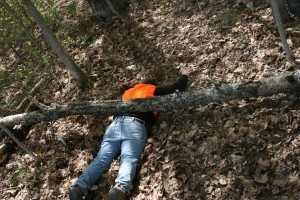
Dang! Another body to hide.
I’d had the husband of the chief psychologist build me a lightweight book return that was installed beside the desk. I had several other places throughout the institute where I taught or retrieved journals for copying, so having a secure return was important. A couple days before April Fools, I realized that it might be fun to put the doormat in the book box and see how people reacted when it screamed at them. The first person to drop off books was a very straight laced psychologist who hardly ever showed any emotion. He dropped off a couple heavy items and turned to walk away. I was in the stacks where I could see him, but not be seen myself. When the scream came, there was two inches of daylight between the soles of his shoes and the carpet. While I caught other people that day, his reaction was the best.
When I took over as head librarian in Boothbay Harbor, I inherited a weekly newspaper column. When April Fools Day came around, I was prepared. Everyone knew the library needed repairs and would eventually need a major renovation. I capitalized on that by writing a column that told the story about how during an environmental inspection, the federal government had discovered a family of Barlow’s Spotted Skinks living in the library cellar. Since these little creatures were on the endangered species list, their presence in the library meant that we would have to close down until a plan to relocate them safely was devised.

Once Upond A Time
I went on to write about a reclusive Asian millionaire named Lirpa Loof, who had a large estate in Edgecomb, the next town on the peninsula. Mr. Loof was going to cover the cost of moving all items from the library to a specially constructed barn on his property, would pay for hourly shuttle buses from the library to his estate and would have his groundskeeper rearrange the gardens so people could read outside in comfort. The reaction was completely unexpected. I thought most everyone would catch the fact that Lirpa Loof was April Fool spelled backward, but apparently not. By the time the dust settled, I had fooled three library board members and two selectmen. I continued to come up with a new prank every year, but the skink one was the best.
When the opportunity to write a weekly column for the Sebasticook Valley newspaper opened up, I was really excited because I knew what a great marketing and P.R. Opportunity it was. When the first April Fools rolled around, I write about my long time friend Dah Nee Buoy. We had gone to Arizona State University together and while I had been fairly studious, Dah had pretty much majored in partying. Time after time, I ended up polishing, or in some cases completing written assignments for him.

Caution: Idiot Zone Ahead
He was always grateful and when we graduated, he said that when the opportunity came, he was going to pay me back ten times over. I chalked this up to youthful grandiosity. All I knew about Dah was that he came from some unpronounceable island in the South Pacific. It wasn’t long before I lost touch with him.
Fast forward thirty-five years. I get a registered letter from Dah telling me that his father, ruler of a small kingdom, has died, leaving him filthy rich and eager to make good on his promise. He wants me to help him set up the best library in the world. Money is no object, the letter says, and the job comes with a six figure income and free housing. Will I accept? Of course.
The paper hadn’t been out on the street for more than half an hour before the first wave of surprised and outraged patrons called or stormed into the library. They told me that I couldn’t leave. I told them to read my friend’s name backwards.
The absolute best prank came right after we spent a long weekend in California. I saw a small incubator in a gift shop with a baby blanket over the top, The sign beside it said “Please don’t disturb the baby rattler.” Of course, I knew what it was, having been snookered by a similar setup when I was a kid, I wrote a nice column about our trip and told readers that I had purchased an egg in a curiosity shop north of Los Angeles. I went on to tell how I smuggled it through security and had kept it warm all through the return flight. It was now incubating in the library. I encouraged everyone to stop in and view the baby rattler.
One of my volunteers brought in an old bassinet and a baby rattle. We put the rattle inside the bassinet and covered it with an old baby blanket. This time, the reaction was unexpected and hilarious. Somebody in Hartland read my column and completely freaked out, calling the county sheriff as well as the Maine game warden service. I was bringing a box of books up from the basement when two serious looking guys entered the building and asked for me. I identified myself and they asked if they could see the baby rattlesnake. I couldn’t help but burst out laughing as I explained that it was an April Fools Day joke and that nowhere in the article had I said I had a snake. They couldn’t decide whether they should be mad or foolish. There was a young dad trying to read to his four year old daughter while the exchange was taking place and by the time I had explained the situation, he was practically in tears he was laughing so hard.

Excuse me, how far it it to Lubec?
What do I have planned today? I’ll tell you in the comments section later today after it runs its course.
Regular readers of MCW know that I’ve struggled to write for a while, in part due to depression. I’m happy to report that the darkness has lifted and I’m working diligently on a new book, one that has been germinating in my head for several months. One thing I’ve noticed while writing this one is how much I got from devouring so many YA books in the past year. The dynamics and the emotional rollercoaster that are a big part of adolescence is present in the new book. In the process, I’ve come to some interesting conclusions that are worth sharing. Some may be helpful to you, others might not be. In any event, I hope for those reading this who aren’t successfully or frequently published, that some of my observations are useful.
First, hold onto the thought that you’re writing for yourself, not an anonymous audience. That piece comes later after you’ve finished the manuscript and it’s ready for semi-prime time. Second, I really believe it helps to block out concern that you might be writing the wrong way. I often think of writing as mental culinary arts. When you cook, you’re preparing a meal that had been cooked multiple times by multiple people, but will probably have a unique taste because of HOW you prepare it. Writing isn’t much different. When you read 150 young adult books a year, you notice certain plot elements will crop up in several books by different authors. What makes book A far more appealing than book B is the way the author ‘cooked’ the plot elements. If you’re like me, you can drive yourself nuts worrying about how a certain section or idea you’re adding sounds or seems like one in the book you read two weeks ago. That’s not unusual and I believe it happens to most, if not all writers. Shrug it off and keep writing.
Third is related to number two. Everyone approaches writing a book a bit differently, but in listening to authors or participating in writing workshops, patterns of development appear and unless you’re very comfortable with your development style, it’s easy to be swayed by what works for someone else if they’re selling it properly. What’s really at stake is how to be comfortable with what you settle on. Some people write a biography for every character, others sketch out the physical geography of the place where the book is set. These and many others work for different writers. What’s really critical is for you to meditate/think about/ponder your style and make sure you’re comfortable with it it makes the process smooth, productive and relatively anxiety free
For me, I need to be alone to write well and I need to have a bag of possibilities hanging on a hook in my brain. When everything is cooking, that bag goes into the shower with me in the morning because that’s where my best ‘new roads’ come into my head and from there into the bag. Lately, I’ve been so wrapped up in grabbing the new stuff that I forget that I’m taking a shower and shut the water off, only to realize that I neglected to rinse the soap out of my armpits, so back in I go.
Don’t be afraid to let your character utilize current technology. Skye Lundquist, my seventeen year old protagonist, is faced with the very real possibility that she’ll be moving from Long Beach, Ca. To Machias, Maine with her frequently freaked-out mother. If Mom wants to fully inherit the two million dollar estate that has been left to her, she needs to live in this lovely Victorian home for a full year in the town she left not long after Skye was born. Since Skye has only vague bits and pieces of memory from the time before she started school, her take on the possible move lies somewhere between terrifying and ideal. It’s terrifying because all she knows is Long Beach, but it’s ideal because of what happened to her at an end of school party the night before she finished her junior year that left her angry, humiliated and friendless. She lives for basketball, and thanks to the internet, she can research just how important basketball is in a remote part of Maine. (The answer, of course, is that it’s pretty damn important to real Mainers, so she’d likely start on the varsity team).
In less than two days of online searching, Skye has a copy of her great aunt’s obituary, has scoped out kids her own age on Facebook who are from the Machias area and has bought a six month membership in Classmates.com because they’ve digitized fifteen years worth of Machias High yearbooks. In the process of looking through them, she found individual shots of each member of the boys’ varsity basketball team and has developed a major crush on one of them. She takes this to a step unheard of just a few years ago, she sends him a friend request on Facebook. These things all are stuff that teens can and do these days. They show readers how different connecting to others and finding information can be these days, even for those who are internet newbies.
I’ll talk more about this book which I’ve given the working title of Singing the L.A. Blues On the Barrens in future columns.
March 30, 2015
Crime Wave Therapy or Self-help for the Mystery Minded
Our guest blogger today is writer Karla Whitney, sharing some of her writer’s journey and the value of conferences and community to a writer.
Back in April 2011, I attended Maine Crime Wave at University of Southern Maine. This was my first step in a self-induced program to face my fears. Although I’d written stacks of college curriculum and collaborated on writing and illustrating textbooks, I had secrets — files no one had seen — fiction, short stories, poetry, and an eighth draft of my first mystery novel. I was too afraid to submit my writing anywhere to anyone, because if I didn’t try, I didn’t risk rejection.
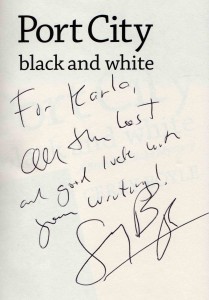 Toby Ball, Gerry Boyle, and Cornelia Reed shared a panel discussion about writing mysteries. During break, I bought Gerry Boyle’s “Port City Black & White”, and asked his advice to a fledgling. He recommended New England Crime Bake as a means of learning about the business, and getting involved in the writing community. He also said writers work very hard, it was tough and competitive to get published, but that if I was any good, and persisted, publication was attainable. He didn’t make it sound easy, but he did make it sound do-able.
Toby Ball, Gerry Boyle, and Cornelia Reed shared a panel discussion about writing mysteries. During break, I bought Gerry Boyle’s “Port City Black & White”, and asked his advice to a fledgling. He recommended New England Crime Bake as a means of learning about the business, and getting involved in the writing community. He also said writers work very hard, it was tough and competitive to get published, but that if I was any good, and persisted, publication was attainable. He didn’t make it sound easy, but he did make it sound do-able.
Later that year, at my first Crime Bake, I felt enormous relief to meet like-minded adults who spend solitary hours upon days, inventing stories, solving crimes, hashing out words, anguishing over imaginary characters (and their pets), all inside their own mind’s eye. I was not alone and I was hooked.
At Crime Bake 2014, I met an agent from Fuse Literary. When I explained my current non-fiction project focused on art and design, she directed me to a colleague at her agency.
Researching http://www.fuseliterary.com/ I discovered ‘Short Fuse Guides’, just $1 each, written by Fuse agents. The guides are smart, savvy and practical, offering de rigueur tips for new and seasoned authors. Topics cover Query Letters, Book Proposals for Fiction and Non-fiction, Marketing, Promotion, Contracts, and more.
Appreciation is ‘feel good’ therapy that doesn’t cost a dime. Thanks are due to Crime Bake and Maine Crime Wave organizers, agents who listen to rapid-fire pitches, panelist who share their time and insights, Level Best Books editors for selecting quality stories and giving new writers a chance, Sisters In Crime and Mystery Writers of America-New England for providing community, and Maine Crime Writers for the range of ideas offered in this blog.
And thanks to Gerry Boyle for sound advice. Somewhere between my first Crime Wave and now, I ditched my fear of trying, applied what I learned in workshops, and tuned my inner ear to the muses. I’m still not crazy about rejection, but who is? Now I understand, like the habit of daily writing, it’s all part of the trade.
This year’s upcoming Crime Wave, sponsored by Maine Writers & Publishers Alliance (MWPA), is April 11th at University of Southern Maine. Panelists include Barbara Ross, Lea Wait, Kate Flora, Gayle Lynds, Brenda Buchanan, Kathy Lynn Emerson, Paul Dorion, Gerry Boyle, Sarah Graves, and more. For information, contact MWPA at www.mainewriters.org or call 207-228-8263.
Karla M Whitney’s first published mystery fiction, ‘More To The Point’, is included in Level Best Books Best New England Crime Stories 2015: Rogue Wave. She’s been drawing pictures, inventing stories, and turning them into books for decades. Her published work includes textbooks, editorial articles, illustrations, layout designs and comics. A second mystery novel percolates, while she polishes short stories and delves into another non-fiction adventure. She’s a member of SINC and MWA, and teaches art, writing and graphic design.
As the Crowd Turns
When I was a young girl, I often came home from school to find my mother standing in the living room at her ironing board, a cigarette in hand, and the television playing her favorite (and if I recall correctly, only) soap opera, As the World Turns.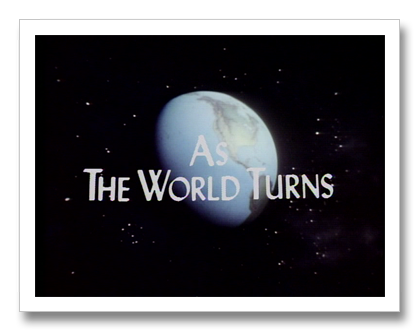
Vicki Doudera here. I myself never really got hooked on soaps, even in the eighties when many of my friends were addicted to the latest twists and turns in the saga of Luke and Laura, two of the favorite characters on All My Children. Of course I’ve seen a few, and one thing they all seem to share are shifting loyalties. Put simply, the characters’ relationships change with the flick of a channel. They’re a fickle bunch, these soap opera folks, and just when you think you know who’ll stand by whom, the plot reverses. Old alliances are broken, new bonds are formed.
The day I equate with extreme fickle flip-floppedness (to coin my own tongue-twister of a term) was yesterday, recognized as Palm Sunday by most of the Christian world. The day marks Jesus’ triumphant entry into Jerusalem, astride a donkey and cheered by the multitudes waving palm branches and yelling “Hosanna,” a term of rejoicing. Picture the Patriots’ Superbowl Championship parade in Boston with JC as a bearded Tom Brady in sandals, and you’ve got the idea.
Accounts of the event are pretty clear that the masses lining the dusty roads saw Jesus as a hero, and yet, five days later those same fans would be calling for his execution. This story line is to me what makes Palm Sunday so chilling: the mood is exultant, and yet we all know what’s coming. This story isn’t going to change. Any joy is fleeting and it won’t be long before those palm branches are ground into dust.
I recently finished a wonderful book called Euphoria, by a fellow Mainer, Lily King. It’s extremely well-written and meticulously plotted, and although it’s not crime fiction, I highly recommend it. 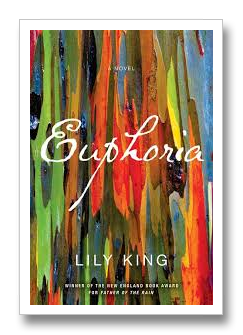
In it, there’s a character who returns unexpectedly and is given a hero’s welcome, with night after night of revelry, dining and drink, but after several days the crowd starts to turn. In church yesterday, that scene from the book came to mind, and I wondered if it’s in the very nature of crowds to be fickle. Are we like a school of fish, swimming together happily in one direction, and then suddenly veering en masse toward a new clump of coral?
The crime writer in me sees the drama in reversals. A happy parade is just a happy parade. But take that procession and, instead of building toward an even happier conclusion, make things start to sour. Something rotten in the state of Denmark – or, Jerusalem. People muttering in their market stalls, Pharisees plotting behind closed doors. Make a trusted advisor turn traitor. Things get dark, so dark that it seems there will never be light again. A horrible death. The grief of friends, the anguish of a mother. The bitter end of a story… or is it?
Easter Sunday gives yet another plot twist, probably one of the world’s most famous and unfathomable. Life arising from death – not the end of the story, but the beginning. Hard to beat that as a revelation, right? But then I think back to those afternoons with the smell of spray starch hanging in the air, mingling with the scent of cigarette smoke, and I hear the strains of As the World Turns, and I’m guessing the writers on that soap may have tried some form of resurrection as well. (The character in a coma comes to mind. Or – the ones you knew had died – and yet – they’re ba-a-a-a-a-k!)
Whatever your personal beliefs, I hope you are touched by the miraculous this week, something special and spiritual, whether it comes from a soap opera, a bouquet of daffodils, or the smile of a neighbor. Happy Easter, Happy Passover, and Happy Spring!
March 27, 2015
Weekend Update: March 28-29, 2015
 Next week at Maine Crime Writers there will be posts by Kate Flora (Monday), special guest Karla Whitney (Tuesday), John Clark (Wednesday), Sarah Graves (Thursday), and on Friday the mini-blog tour of this year’s Agatha Award short story finalists (Kathy Lynn Emerson, Barb Goffman, Edith Maxwell, and Art Taylor) comes to Maine Crime Writers.
Next week at Maine Crime Writers there will be posts by Kate Flora (Monday), special guest Karla Whitney (Tuesday), John Clark (Wednesday), Sarah Graves (Thursday), and on Friday the mini-blog tour of this year’s Agatha Award short story finalists (Kathy Lynn Emerson, Barb Goffman, Edith Maxwell, and Art Taylor) comes to Maine Crime Writers.
In the news department, here’s what’s happening with some of us who blog regularly at Maine Crime Writers:
Lea Wait will be Skyping with several schools during the coming week; most of the classes have read either her Agatha-nominated Uncertain Glory or Finest Kind. Later this spring she’s looking forward to taking several school groups on tours of Wiscasset and the old jail there …. the site of her historical novels for young people.
Kate Flora will be speaking at the Portland Public Library’s Brown Bag Lecture Series on Wednesday, April 8th at 12:00.
Dorothy Cannell, Barbara Ross, and Kate Flora will be doing at Chat with Champions on Thursday, April 9th at 10:00 a.m. at the Skidompha Library, 184 Maine Street in Damariscotta.
If you are looking for a fun event, a lot of Maine Crime bloggers and alums will be at the Portland Public Library on Friday, April 10th for a social gathering and brave two minute readings by Maine crime writers at Two Minutes in the Slammer. Dining afterward with one of your favorite writers. Last year, Crime Wave participants said they wanted more time to socialize–so here it is. Hope to see you there. And remember: this is not just for writers. If we gather a room full of librarians, that will be good fun. You ever see librarians party? Well…come on down.http://mainewriters.org/two-minutes-in-the-slammer-a-friday-night-social-for-the-2015-maine-crime-wave/
Time is running out to sign up for the Maine Crime Wave, our own mystery conference. More information here: http://mainewriters.org/2015-maine-crime-wave/
A question for you. We here at MCW are gearing up for National Library Week, when we get to celebrate Maine libraries and Maine librarians. If you’d like to be our guest, or suggest someone who should be a guest, please let us know.
An invitation to readers of this blog: Do you have news relating to Maine, Crime, or Writing? We’d love to hear from you. Just comment below to share. Don’t forget that comments are entered for a chance to win our wonderful basket of books and the very special moose and lobster cookie cutters.
And a reminder: If your library, school, or organization is looking for a speaker, we are often available to talk about the writing process, research, where we get our ideas, and other mysteries of the business. Contact Kate Flora: mailto: kateflora@gmail.com
March 26, 2015
Coming Soon: The Body in the Birches from Katherine Hall Page
Today’s special guest blogger is MCW’s friend and frequent contributor, Katherine Hall Page, giving us a glimpse into her forthcoming mystery.
 The epigraph for The Body in the Birches (May, 2015) is from the master of them all, Oscar Wilde. He wrote: “After a good dinner one can forgive anybody, even one’s own relations”. Definitely food for thought, especially when considering inheritance—that all important familial divvying up. Nice and convenient when it’s laid out in an iron clad will, but more often than not people kick off the mortal coil without making final provisions. This may be because they have trouble facing death, the basic fact of life—i.e. “I’m not going”. Or equally common is simply the inability, or desire, to decide who gets what—the “I won’t be here, so let the chips fall where” attitude.
The epigraph for The Body in the Birches (May, 2015) is from the master of them all, Oscar Wilde. He wrote: “After a good dinner one can forgive anybody, even one’s own relations”. Definitely food for thought, especially when considering inheritance—that all important familial divvying up. Nice and convenient when it’s laid out in an iron clad will, but more often than not people kick off the mortal coil without making final provisions. This may be because they have trouble facing death, the basic fact of life—i.e. “I’m not going”. Or equally common is simply the inability, or desire, to decide who gets what—the “I won’t be here, so let the chips fall where” attitude.
The Body in the Birches is the story of what happens in one  family as a result of not naming an heir. The late Priscilla Proctor, childless, could not bring herself to choose who among her nieces and nephews should inherit The Birches, a much beloved “cottage” on Sanpere Island in Penobscot Bay, Maine. It is treasured by them all, and is a treasure—with substantial waterfront looking toward the Camden Hills plus several acres of land. Far in size and scope from what Mainers call a “camp”, Priscilla knows it would be difficult to share decisions about the maintenance of the house and other matters. There can be only one owner. She leaves instructions for her husband Paul to inform all who are interested in taking on The Birches to spend as much of the month of July as possible there for a kind of audition. Paul—not a Proctor—will choose who inherits at the end of the month. It was Paul, who has life tenancy, who came up with the plan to spare his increasingly agitated wife the decision and presumably Priscilla died at peace. Peace does not reign among the living, however, and if the book reminds you of the film, “Kind Hearts and Coronets”, my job will have been happily fulfilled.
family as a result of not naming an heir. The late Priscilla Proctor, childless, could not bring herself to choose who among her nieces and nephews should inherit The Birches, a much beloved “cottage” on Sanpere Island in Penobscot Bay, Maine. It is treasured by them all, and is a treasure—with substantial waterfront looking toward the Camden Hills plus several acres of land. Far in size and scope from what Mainers call a “camp”, Priscilla knows it would be difficult to share decisions about the maintenance of the house and other matters. There can be only one owner. She leaves instructions for her husband Paul to inform all who are interested in taking on The Birches to spend as much of the month of July as possible there for a kind of audition. Paul—not a Proctor—will choose who inherits at the end of the month. It was Paul, who has life tenancy, who came up with the plan to spare his increasingly agitated wife the decision and presumably Priscilla died at peace. Peace does not reign among the living, however, and if the book reminds you of the film, “Kind Hearts and Coronets”, my job will have been happily fulfilled.
 Faith Fairchild, my series sleuth, and family are conveniently living next door to The Birches at The
Faith Fairchild, my series sleuth, and family are conveniently living next door to The Birches at The
Pines with Ursula Rowe while the Fairchild cottage, definitely a cottage, gains a much needed addition. The kids are growing fast and Faith’s husband, the Reverend Tom, wants a room of his own where he can get away to ponder the mysteries of the universe and watch the Red Sox, who qualify depending on the season. As usual, there is a great deal of food in the book and several lovely murders with extremely unusual suspects. We close at summer’s end strolling around the Blue Hill Fair eating the Fry King and Queen’s fries doused with vinegar.
I loved writing this book—well, perhaps not the actual writing it down part, but the writing it in my head part. As with all the ones set in Maine, it gave me a chance to write about the place itself. This summer will be our 57th on Deer Isle and, counting two weeks on a lake near Readfield when I was four, 58th overall! We were not rusticators, although my father did swim every day in what I didn’t realize was very cold water until I was much older and went for a dip on Cape Cod. It was like swimming in bath water! Who knew? I still swim every day both because it is now thoroughly engrained and also because perhaps I’ll keep longer. And considering my parents had the foresight to purchase a plot where they now rest, I should be on the island for good
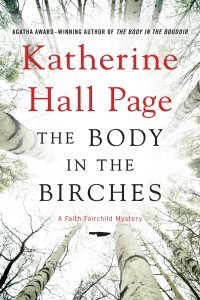 The Body in the Birches is the 22nd in Katherine Hall Page’s Faith Fairchild series. She has also published for middle grade and YA readers as well as a collection of short stories, Small Plates (2014), and a series cookbook, Have Faith in your Kitchen. She has been awarded Agathas for Best First, Best Novel, and Best SS and also was nominated for additional Agathas, an Edgar, Macavity, Mary Higgins Clark and the Maine Writers & Publishers Alliance Literary Award for Crime Fiction. She lives in Maine and Massachusetts.
The Body in the Birches is the 22nd in Katherine Hall Page’s Faith Fairchild series. She has also published for middle grade and YA readers as well as a collection of short stories, Small Plates (2014), and a series cookbook, Have Faith in your Kitchen. She has been awarded Agathas for Best First, Best Novel, and Best SS and also was nominated for additional Agathas, an Edgar, Macavity, Mary Higgins Clark and the Maine Writers & Publishers Alliance Literary Award for Crime Fiction. She lives in Maine and Massachusetts.
March 25, 2015
Would You Believe?
Dorothy Cannell here. A few weeks ago my husband Julian mentioned that he was joining the  Masons. Mentioned – not announced, let alone confessed. To say I was shocked to the core puts it mildly. If he’d said he’d decided to become a Trapist monk I would have been more like to say – “Oh, really?” In all our years of marriage he’d never once expressed any leanings in the Masonic direction. As a schoolgirl at a Roman Catholic school, I had gleaned the information that membership was forbidden by the church meaning members went to hell without passing Go and collecting two hundred dollars. But this was not what now bothered me. What other deep yearnings, I asked myself, had the love of my life been keeping from me?
Masons. Mentioned – not announced, let alone confessed. To say I was shocked to the core puts it mildly. If he’d said he’d decided to become a Trapist monk I would have been more like to say – “Oh, really?” In all our years of marriage he’d never once expressed any leanings in the Masonic direction. As a schoolgirl at a Roman Catholic school, I had gleaned the information that membership was forbidden by the church meaning members went to hell without passing Go and collecting two hundred dollars. But this was not what now bothered me. What other deep yearnings, I asked myself, had the love of my life been keeping from me?
“Why?” I asked. “You’ve never been one for organizations.”
“A friend invited me.”
“Well, isn’t that nice!” I beamed. And of course it was. “I know they do a lot of good work.” I was about to add I hoped he’d enjoy himself but decided might not be one of the objectives.
 I mention this occurrence because in real life people often surprise us by acting in a way we regard as wholely out of character in a way that wouldn’t be acceptable with a series character in fiction. Several years ago, I had been equally amazed when Julian broke the news to me that he was growing a beard. He’d formerly disapproved of them when worn by fellow lawyers. Then there was the abrupt change of attitude to his car, going from wiping off anything verging on a fingerprint and expecting passengers to wear slippers, to allowing it to look like an abandoned orphan. But try imagining Miss Marple suddenly announcing she was giving up knitting and taking up horseback riding instead? Or Poirot announcing that all the stuff about the little gray cells was bunk and what counted in detection was getting in touch with one’s feminine side? Or Lord Peter Wimsey firing Bunter because of an overwhelming urge to do his own housework and cooking. Couldn’t be done without enraging the reader, unless causing him or her to take the compassionate view that the author, not the character, had gone batty. Assumption: Credulity can be stretched much further off the page than on. And yet it is expected in the modern mystery series that the main character should evolve over the course time. Question: How to accomplish this in a manner that is not contradictory but satisfying and enriching manner?
I mention this occurrence because in real life people often surprise us by acting in a way we regard as wholely out of character in a way that wouldn’t be acceptable with a series character in fiction. Several years ago, I had been equally amazed when Julian broke the news to me that he was growing a beard. He’d formerly disapproved of them when worn by fellow lawyers. Then there was the abrupt change of attitude to his car, going from wiping off anything verging on a fingerprint and expecting passengers to wear slippers, to allowing it to look like an abandoned orphan. But try imagining Miss Marple suddenly announcing she was giving up knitting and taking up horseback riding instead? Or Poirot announcing that all the stuff about the little gray cells was bunk and what counted in detection was getting in touch with one’s feminine side? Or Lord Peter Wimsey firing Bunter because of an overwhelming urge to do his own housework and cooking. Couldn’t be done without enraging the reader, unless causing him or her to take the compassionate view that the author, not the character, had gone batty. Assumption: Credulity can be stretched much further off the page than on. And yet it is expected in the modern mystery series that the main character should evolve over the course time. Question: How to accomplish this in a manner that is not contradictory but satisfying and enriching manner?
I am thinking about this while getting ready to start the third in my series set in the nineteen thirties featuring Florence Norris. It would be easier if she were young, but she is a woman in her forties. Making for a challenge. In the meantime I’m writing a short story. Opening line: “My dear, such stunning news! Mr. Bartlett has joined the Masons. His poor wife never had an inkling he had any such intentions!”
March 24, 2015
Four Lies Book Publicists Will Tell You
Hi. Barb here. At home in Somerville, MA, but venturing to Maine early next month.
My experience is that, if you write fiction, whether you are a new author, or a mid-career author adapting to the brave new world of publishing, there are people around who will give you incredibly terrible advice.
I don’t mean your mom. (“Why don’t you go on Oprah, dear?” “Gee, thanks. I never thought of that.”) I mean people who make their living publicizing books. Publicists you pay, “experts” in the field, even your assigned publicist at your publisher. And since these people have conversations with your editor who has conversations with your agent, there are many, many channels through which bad advice can reach you.
Of course, I don’t mean all publicists, experts, editors and agents give bad advice. Many will give you great advice. Others will give you honest advice–i.e. they will say, “I have no #$%^ing idea.”
Most of the people who give bad advice don’t mean you any harm. They believe what they are telling you. They give you poor information for the following reasons:
1) Nobody really knows the answer. There is not, nor has there ever been, a magic formula that turns books into bestsellers. If there were, every book would be a bestseller.
2) Nobody really understands the brave new world of publishing. It’s too new and changing too fast. To quote William Goldman, “The only thing anybody knows is that nobody knows anything.”
3) Marketing, in general, is an ill-understood activity. John Wanamaker (1838-1922) famously said, “I know that half of my advertising dollars are wasted … I just don’t know which half.” When you generalize from advertising to all of marketing, and when you look at both dollars and effort, I think you’re talking more in the range of 90% wasted. Huge corporations that have millions to spend on focus groups and other semi-scientific ways of judging their marketing still make horrible missteps. And waste a whole lot of effort. But remember, 10% of it works.
So given these challenges, there’s a huge tendency for people to over-generalize. To desperately take whatever worked last time and apply to something new, even if the situation is different. Or to try to reverse engineer success. “Well, this book was a huge success, and the author did A, B & C, so therefore, everybody do A, B & C!”
I don’t have an issue with this. What I have an issue with is the advice that is damagingly bad, and that goes around and around and around. So herewith is my assessment of publicity advice you should absolutely ignore.
1) Don’t waste your time marketing to other writers. You should be focused entirely on readers.
Of all the stupid things people say, this is the stupidest. It’s true that as you come up through the writer ranks, you’ll get to know a lot of fellow authors, both established and aspiring. Sometimes it will feel like all your Facebook friends and other social media followers, all your blog readers and all the people you hang out at conventions with are fellow authors. But authors are incredibly important to you from a marketing perspective.
Most authors are voracious readers first and foremost. They read books and they talk to their friends about books. They hang out in places where people read books and talk about books. Leaving aside the psychological benefits of having a supportive network of friends, having a buzz about your book among writers is priceless. They will recommend you for speaking gigs. They will blurb you. One of the most common questions writers get when they do presentations is, “So who do you like to read?” There’s a reason almost all the reviews in the New York Times Book Review are written by writers.
Whatever you do, please, do not go wandering the earth looking for a lost herd of “readers,” and ignore the very readers it is easiest for you to find, your fellow writers.
2) Readers aren’t interested in writerly stuff.
I actually believed this one, which is sort of a corollary to the above. So when I did “Reader” events I talked about things I thought would interest readers, things about the setting, characters and mystery elements in my books.
But whenever Q&A time rolled around, someone always put up his hand and asked, “So do you write in the morning, or in the evening, or what?”
I know. I don’t get it, either. But I’ve observed this now at lots of writer events, including really famous writer’s events. Some of the questioners are aspiring writers, sure, but others are not. It’s just something the kind of dedicated readers who read writers’ blogs and websites and magazine interviews and who come out to events want to know. They also want to know, do you have a special place where you write? Do you plan a whole book first? All that stuff.
3) Fiction writers need to develop a platform of thousands of Twitter followers and blog readers before they get published.
So let’s talk about the platform thing. A platform is where you stand so people can see you. It helps people find you, and therefore find your book.
Obviously for certain kinds of non-fiction writers, the platform is huge. If you’re a business guru going around the world doing guru seminars, and you’ve written a book to sell at the back of the room, your platform is everything.
For other non-fiction authors, the platform proves their bona fides. If you’ve written a book about the Civil War and you have a university appointment in a history department where you are the resident expert on the Civil War, that’s important. If you are an award-winning journalist, that’s important, too.
In the modern world, the height of your platform often gets measured in social media followers and blog readers, but those are the results of the platform, not the platform itself. You don’t stand on the audience’s heads. You stand on your platform so the audience can see you.
If you are a fiction writer, your platform is your books. Your books are what cause you have an audience, not the other way around. The single greatest reason people purchase fiction is that they have read the author before and liked (loved) their work. And mystery and thriller writers are the most brand loyal and least adventurous of all. As Julia Spencer-Fleming says, “Your book sells your next book.”
So if you are focused on building a Twitter following instead of spending every moment making your book the best book it can be, stop it right now.
I’m not saying the modern mid-list writer should ignore social media or eschew other promotional activities. Once you have an audience, even a small one, it is your most precious asset. You should find as many ways to reach your readers and cultivate them and keep them interested and get them talking about and recommending your books as you can. If you have a new book out, and someone who love-loves you hasn’t heard about it, it’s a shame for them and shame on you.
But growing an audience without a platform–i.e. without a book, is difficult and inefficient.
And if you happen across a publisher who wants to know how many Twitter followers and Facebook friends and blog readers you have before he will commit to publishing your first novel, don’t walk, run.
4) You should do a blog and build a big social media following about something in the world of your book, but not writing.
This is the obvious off-shoot of all three of the above. 1) You should be cultivating readers, not writers. 2) Readers are not interested in writerly stuff. 3) You need a huge platform. Therefore, 4) you should be blogging about something else.
The main reason this is terrible advice is because building a successful blog is an actual skill. If you have the kind of mad enthusiasm for a topic, distinctive and compelling voice, high energy work ethic and productivity required to build a large and faithful blog following, you should consider becoming a blogger instead of a novelist. Because, believe me, it is equally hard, and the last thing you need is another poorly compensated, all-consuming activity to suck up all your time. You already have one. You’re a novelist.
It’s like telling someone to become a virtuoso rock guitarist so they can play in a symphony orchestra. They’re related skills, but not the same skill.
It’s also crazy inefficient. Say you are writing a mystery set in the world of windsurfing. Brilliantly, you build the world’s most popular windsurfing blog.
The theory is these readers will buy your mystery. Like this.
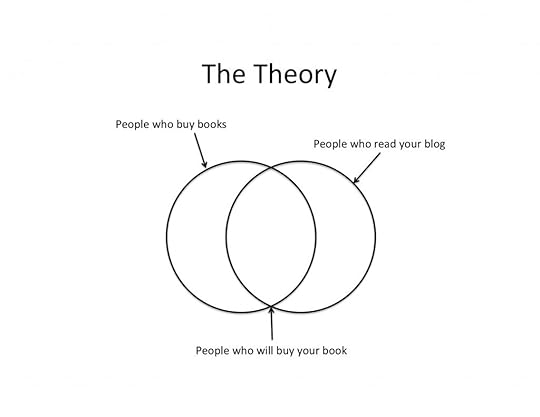 But how it actually works will be more like this.
But how it actually works will be more like this.
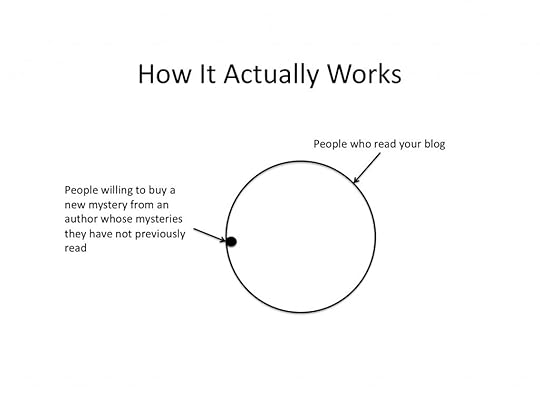 Not that I am casting aspersions on the general literacy of windsurfers. At all. And note that I’ve indicated you’ll get 90% of the overlap, except for the few dumb asses who will forget to buy your book, or the ones who steal it from their local surf shop. The reason the circle is so small is because of this:
Not that I am casting aspersions on the general literacy of windsurfers. At all. And note that I’ve indicated you’ll get 90% of the overlap, except for the few dumb asses who will forget to buy your book, or the ones who steal it from their local surf shop. The reason the circle is so small is because of this:
 This is not at all drawn to scale. Because if it was, it would look way, way worse than this. But you get the idea.
This is not at all drawn to scale. Because if it was, it would look way, way worse than this. But you get the idea.
Willie Sutton said he robbed banks because, “that’s where the money is.” When you’re starting out, you need to focus your marketing efforts on the highly limited number of people who will buy a mystery from an unknown author. Because that’s where the money is. (Actually, there’s no money to speak of anywhere, but that’s an entirely different topic.)
So why so negative, Barb. Why spend this endless blog telling people what not to do? What should we do?
Stay tuned for Part II.
March 23, 2015
Sometimes S#&T Just Happens or When I Knew I Would Become A Writer
Al Lamanda here. Sometimes in life, s#&t just happens all by itself and seemingly for no good reason. Trust me; there is a reason, and a cause and an outcome. Most of the time, we’re too busy leading our lives to recognize the reason and cause, just the s#&t that happened to us and the outcome, and sometimes not even the outcome is revealed to us until much later down the road.
Some prime examples of some s#&t that happened to me for no good reason over this past miserable winter (stop me if you’ve heard any of this before) started in late December. It snowed (yeah, I know, you too) often and a lot. Except that it didn’t snow as scheduled. By this, I mean I would watch the weather report and it would say to expect up to a half foot of new snow the next day. I would prepare for the snow beginning with the exotic dance of moving the cars so the plow guy can plow the driveway and backyard. The dance of the cars is followed by positioning the shovels and boots for early morning use. Come morning, I would be fully prepared to shovel the walkway, deck and return the cars to their regular less exotic spots. Except that in the morning, there wasn’t a hint of snow on the ground. Odd, but the weather channel does make mistakes from time to time. Except that a few days later, the weather report didn’t mention snow and I woke up to nearly a foot of snow on the ground. No fair as I didn’t get the chance to conduct the exotic dance of the moving cars. This, it will, it won’t weather reporting went on for weeks leading up to the storm of the millennium, nicknamed by the weather gods, the snowicane. The snowicane had people running to the stores for bottled water, canned goods, bread, candles and batteries as if they were all contestants on The Price is Right and their names had just been called. Expected snowfall totals of three feet, with hurricane winds and power outages, so the weather gods predicted. I went to bed fully prepared and awoke to a few inches of fluffy snow that I swept off the walkway with a broom. And went about my business of packing and preparing for a planned vacation to Puerto Rico. Then, thirty-six hours before the flight, the airlines and weather reports issued a travel advisory. Snow. Winds. Snowicane conditions. The day of my flight, which was canceled by the way, the news stations were gloom and dooming about the raging storm while I was looking out my window at a calm, sunny day. My flight was rescheduled for the following morning, a day that no mention of snow or storm was in the forecast. So as I drove to the airport in a whiteout conditions, two things crossed my mind. The first was that I would never make it to the airport. The second was that I would never make it to Puerto Rico. Although we took off in a white out, the flight was surprisingly smooth sailing the entire trip.
winter (stop me if you’ve heard any of this before) started in late December. It snowed (yeah, I know, you too) often and a lot. Except that it didn’t snow as scheduled. By this, I mean I would watch the weather report and it would say to expect up to a half foot of new snow the next day. I would prepare for the snow beginning with the exotic dance of moving the cars so the plow guy can plow the driveway and backyard. The dance of the cars is followed by positioning the shovels and boots for early morning use. Come morning, I would be fully prepared to shovel the walkway, deck and return the cars to their regular less exotic spots. Except that in the morning, there wasn’t a hint of snow on the ground. Odd, but the weather channel does make mistakes from time to time. Except that a few days later, the weather report didn’t mention snow and I woke up to nearly a foot of snow on the ground. No fair as I didn’t get the chance to conduct the exotic dance of the moving cars. This, it will, it won’t weather reporting went on for weeks leading up to the storm of the millennium, nicknamed by the weather gods, the snowicane. The snowicane had people running to the stores for bottled water, canned goods, bread, candles and batteries as if they were all contestants on The Price is Right and their names had just been called. Expected snowfall totals of three feet, with hurricane winds and power outages, so the weather gods predicted. I went to bed fully prepared and awoke to a few inches of fluffy snow that I swept off the walkway with a broom. And went about my business of packing and preparing for a planned vacation to Puerto Rico. Then, thirty-six hours before the flight, the airlines and weather reports issued a travel advisory. Snow. Winds. Snowicane conditions. The day of my flight, which was canceled by the way, the news stations were gloom and dooming about the raging storm while I was looking out my window at a calm, sunny day. My flight was rescheduled for the following morning, a day that no mention of snow or storm was in the forecast. So as I drove to the airport in a whiteout conditions, two things crossed my mind. The first was that I would never make it to the airport. The second was that I would never make it to Puerto Rico. Although we took off in a white out, the flight was surprisingly smooth sailing the entire trip.
While in Puerto Rico, enjoying the 85-90 degree sun, I kept hearing reports of snow and frigid cold back home, but decided to worry about that later and relaxed on the beach. A few days before leaving for Puerto Rico, this happened.
 I was writing at my desk when I noticed that my cat was taking a keen interest in something on the rug. I investigated and discovered that my cat was watching a lady bug. I was about to squash said lady bug when my better half intervened on the lady bug’s behalf. Because lady bugs are cute little creatures that bring to mind Herbie the Love Bug, my better half had a fit that I wanted to kill it. She wanted to set it free. When I politely pointed out that it was six degrees outside and said Herbie would freeze to death, the result was the same as squishing the little bugger. Lady Bugs are beetles, smaller cousins to the dung beetles who spend most of their time rolling around in … well, you get the idea. Also, they bite. So while the better half and I were discussing the merits of squishing or freezing the lady bug, it up and vanished. We conducted a search of the living room, but the little bugger was nowhere to be had. I suspected that my cat had solved the matter by simply making a snack of the little creature and didn’t give it a second thought. Until the warm sunshine of Puerto Rico was behind us and freezing cold and snow greeted us at the airport. Along with hundreds of lady bugs in the house. They were everywhere, and I do mean everywhere. In lamp shades, the rugs, window ledges, my desk, my keyboard and even the bathroom sink. About the only place the lady bugs weren’t was inside my cat’s stomach, because as it turns out my cat doesn’t like to eat them, just watch them crawl around. My better half changed her tune of save the lady bug and you can guess the rest.
I was writing at my desk when I noticed that my cat was taking a keen interest in something on the rug. I investigated and discovered that my cat was watching a lady bug. I was about to squash said lady bug when my better half intervened on the lady bug’s behalf. Because lady bugs are cute little creatures that bring to mind Herbie the Love Bug, my better half had a fit that I wanted to kill it. She wanted to set it free. When I politely pointed out that it was six degrees outside and said Herbie would freeze to death, the result was the same as squishing the little bugger. Lady Bugs are beetles, smaller cousins to the dung beetles who spend most of their time rolling around in … well, you get the idea. Also, they bite. So while the better half and I were discussing the merits of squishing or freezing the lady bug, it up and vanished. We conducted a search of the living room, but the little bugger was nowhere to be had. I suspected that my cat had solved the matter by simply making a snack of the little creature and didn’t give it a second thought. Until the warm sunshine of Puerto Rico was behind us and freezing cold and snow greeted us at the airport. Along with hundreds of lady bugs in the house. They were everywhere, and I do mean everywhere. In lamp shades, the rugs, window ledges, my desk, my keyboard and even the bathroom sink. About the only place the lady bugs weren’t was inside my cat’s stomach, because as it turns out my cat doesn’t like to eat them, just watch them crawl around. My better half changed her tune of save the lady bug and you can guess the rest.
A few days after returning from Puerto Rico and dealing with the lady bug situation, this happened. I woke up and stumbled to the bathroom and brushed my teeth. Usually brushing your teeth is about as exciting as, well, brushing your teeth. Except that usually when I run the water in the sink, the water drains. Usually. Not that day, no, no, no. That day the sink just filled and filled even though the drain hole was wide open. I checked the kitchen sink, same thing. My pipes weren’t frozen, but the septic tank was. According to the company that deals with this sort of thing, while I was away basking in the sun, the lack of running water coupled with the sub-zero temperatures resulted in a frozen septic tank. The first order of business was to remove the snow from where the tank is buried in the backyard and then await their arrival. Easier said than done when there is six feet of snow covering the location of the tank. The emergency company said they would be there within the hour, which meant three, so I had plenty of time to remove the snow. Three hours later, when they arrived, I had the area clear. And the ground was frozen. Rock hard. So on a freezing February day, I stood by and watched as men with jackhammers tore up my yard. To unfreeze the tank that froze because I flew to Puerto Rico in a blizzard on a day when it wasn’t supposed to snow but did anyway. And while I was standing there in my yard that now resembled a construction site and smelled like a three-hundred-cow dairy farm, I felt something nibble on my left ear. I removed my hat and, you guessed it, found a lady bug.
So sometimes in life s#&t happens and most of the time we don’t know why and what the outcome will be, but sometimes we do. If we reflect back upon it.
At a recent library event, I was asked by a young woman if I always knew I would be a writer, and if so, when did I know? The answer to that question goes back a very long ways to some s#&t that happened to me when I was eleven-years-old.
My roots are in The Bronx, a borough of New York City. I grew up with cement sidewalks, three-sewer stickball and open fire hydrants in the summer as my beach getaway. Summer tans were acquired on Tar Beach, otherwise known as flat, tar-covered rooftops. We didn’t swim or water ski or play volley ball in the sand. Snow was good for just one thing, snowball fights. Nobody skied down a mountain and drank a hot toddy afterward at the lodge in front of a crackling fire. The only crackling fire I ever stood in front of as a kid was when a neighborhood house burned down, which was a frequent occurrence in The Bronx. People would bring lawn chairs and we would sit and cheer on the fire department and hope they would leave the hydrant on afterward. Sometimes, if the fire was big enough, people would bring food and drink for the firefighters and make it an all day event. Bets were placed on how much furniture the firefighters could save so that afterward the owners of the burned down house could have a fire sale.
I was, I believe eleven-years-old before I ever set foot out of The Bronx. Some distant relatives got together with my parents and decided it was a good idea to have me spend a month with said distant relatives at their place in the country. Which turned out to be a three-hundred cow dairy farm in upstate New York (which is how I knew what my backyard smelled like on that cold day in February some fifty plus years later.) My first impression of my distant cousin’s farm was that (you guessed it) it smelled really bad. There were no sidewalks or tall buildings and nothing was made of cement. There were a lot of cows and they seemed not to do much of anything except stand around and chew a lot. The large farmhouse was clustered with old stuff in every corner of every room, and the television was a small black and white set that sat on a small stand in the kitchen that didn’t get much use due to poor reception. Why, of why, was this happening to me? My distant cousin was an avid reader, as were his kids and books were everywhere. There must have been five hundred books scattered about the house. Now I’d read books before, it was required for school, but never for fun and usually meant a written book report to follow. Why read when you can watch Bonanza, Have Gun Will Travel and Gunsmoke?
That opinion changed during the second week on the farm. After dinner one night, when there was nothing to do except watch my cousins read, it was suggested to me to dig through the library and find a book to read. Up to that point, I had learned to milk a cow by hand, something still done to warm the cow up before using the milking machine, to shovel manure without getting any on me, to bail hay and make my own butter, so why not try reading a book.
I went through the library and found a paperback copy of Twenty Thousand Leagues Under the Sea, by Jules Verne. My first impression was what’s a league and do you need twenty thousand of them? But, bored with nothing else to do, I sat on the living room sofa and started to read. It was the first time in my life that I read something for pleasure and not because a book report was due. Without ever leaving the sofa, I was transported to faraway lands on wild adventures and met exciting heroes and characters, and all without turning a knob or buying a ticket. I finished the book in two nights and read Around the World in Eighty Days next. After that I discovered H. G. Wells, Bram Stoker and Arthur Conan Doyle. On the day I was to return home, my cousin allowed me to take whatever books I wanted to read. I took about a dozen. On the drive home, my dad put a ballgame on the radio, but I was too busy reading in the back seat to listen. It was then, at age eleven that I knew that one day I would be a writer, and hopefully to be able to transport someone to a faraway place and take them on an adventure without them ever having to leave their living room. That burning desire to be a storyteller has stayed with me since and burns as brightly today as when I was eleven.
So sometimes s#&t happens in life, and sometimes it may smell like a three-hundred-cow dairy farm, but sometimes that’s not such a bad thing.
March 22, 2015
Creating a Character Bible
Lea Wait, here,. A couple of weeks ago I wrote a blog about what I needed to do after I’d finished a book. One task I mentioned was updating my Character Bible. E.J. Runyon contacted me and asked that I explain what that was. So today I’m sharing how to create a writing tool I develop for each book I write. I find it important for stand-alone books — and indispensable for writing a series.
A character Bible.
No; I’m not referring to THE Bible.
I’m referring to a place — a notebook, an electronic file, a folder …. whatever you choose … that contains the important facts about the people and places in your book. Who wants a character to change eye colors between chapters two and twenty?
Everyone has to find their own “best way” to create a useful Bible. I’ve found a hand-written loose leaf notebook is easiest for me. I can update it by hand either while I’m writing or after … I can refer to it easily … and I can add (or sometimes subtract) pages when necessary. Some years ago I treated myself to a really nice leather “circa” notebook from Levenger, because it’s a comfortable size to take with me if I’m writing on the road, 6.5 x 8.5 inches, and I love the way it looks and feels. Since I use it all the time,I think of it as an investment. At the moment it contains information about the people and  places in both my Shadows Antique Print Mystery series and my Mainely Needlepoint Series.
places in both my Shadows Antique Print Mystery series and my Mainely Needlepoint Series.
OK — what’s in there? Maps of the major towns where the books are set — in these cases, Haven Harbor and Weymouth, Maine, and the campus where Maggie Summer teaches in New Jersey. If another town appears in a book I also draw maps … but usually I leave them in the folder of back-up information (research, ideas, outline, etc) I keep for each book.
Most of my Bible is made up of alphabetical listings of information about each character. A character who only appears in one book may have a short listing — how old he or she is, what they look like, and specific quirks they have, what their secret is, what they want, and what they’re willing to do to get it, and perhaps their relation to my series protagonist and to the specific plot line.
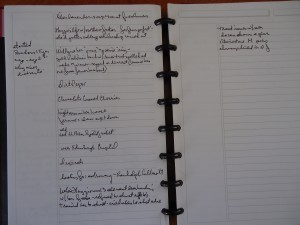 In a mystery, if they’re either murdered or the murderer, that may be all I need — they’ll only appear in one, or maybe two, books.
In a mystery, if they’re either murdered or the murderer, that may be all I need — they’ll only appear in one, or maybe two, books.
For my major, repeating, characters, I include not only that basic information but other details.
For instance, my Bible tells me Maggie Summer (in the Shadows series) has never smoked, drinks Diet Pepsi, and loves chocolate covered cherries. She pays high taxes on her house in NJ. She drinks Dry Sack sherry out of Edinburgh Crystal. She likes to treat herself to baths with lavender-scented soap. Her father took her deer hunting when she was 13 but she refused to shoot, even though he’d taught her how to use a gun. She cried when he killed a doe. (He never took her hunting again.) And so forth
Angie Curtis, the protagonist of the Mainely Needlepint series? Her Gram calls her “Angel.” She has a birthmark on her shoulder that matches one her mother had. She has scars on her toes from walking on barnacle-covered rocks as a child. She drives a small red Honda, likes her coffee black, and is pretty flexible about her choice of beers – but prefers those made in Maine.
Gussie White reads late at night, so it’s OK to call her then. Aunt Nettie has a Thursday morning appointment every week at Cut ‘n’ Curl. Angie Curtis’ fashion-plate friend Clem Walker was fat as a teenager and now works for Channel 7 in Portland.
Not all those details appear in all my books — but they have been mentioned in at least one. The real purpose of the Bible is to ensure that my words don’t contradict themselves. I don’t want Maggie eating chocolate covered cherries in one book and being allergic to cherries in another. (If I don’t notice, one of my readers definitely will!)
The character Bible is also the place to include backstories, phobias, hair styles, fears and goals.
In addition to characters, I have pages for specific places — Harbor Haunts, a restaurant in Haven Harbor, has red Formica counters. Maggie Summer’s kitchen table is pine. What kind of trees are on the main street of town? What do characters’ houses look like? How far away are local hospitals, and how long does it take to drive there? All details that may be important in more than one book.
When do I put information in my Bible? I used to create or add information when I was planning my book. But although I do a general outline of each book before I start writing, I tend to change details as I write. So, for me, the time to create my Bible is when I’ve finished a strong draft, or when I send the manuscript to my editor.
Having the Bible helps avoid changing a character’s hair color, or height, or the name of his or her ex-spouse. It’s also a convenient place to check that I haven’t created two characters with the same first name (ouch! yes, that’s happened) or even two characters with similar last names. I try, in fact, to have all character names in one book start with different letters. That makes it easier for readers to keep them straight. (Me, too.)
Reading through the Bible not only makes sure I don’t make continuity mistakes; it also gives me ideas for future plots, and doesn’t let me forget minor characters who might have key roles to play in future books.
It is right next to my thesaurus and dictionary on my desk.
It is essential.
March 20, 2015
Weekend Update: March 21-22, 2015
 Next week at Maine Crime Writers there will be posts by Lea Wait (Monday), Al Lamanda (Tuesday), Barb Ross (Wednesday), Dorothy Cannell (Thursday), and Katherine Hall Page (Friday).
Next week at Maine Crime Writers there will be posts by Lea Wait (Monday), Al Lamanda (Tuesday), Barb Ross (Wednesday), Dorothy Cannell (Thursday), and Katherine Hall Page (Friday).
In the news department, here’s what’s happening with some of us who blog regularly at Maine Crime Writers:
If you’re not sure you’re up for an all-day conference, but you’d love to meet Maine’s crime writers and/or try out your deathless prose why not come to the Friday night pre-Crime Wave social at the Portland Public Library on April 10? Here are the details::
Two Minutes in the Slammer April 10 event
An invitation to readers of this blog: Do you have news relating to Maine, Crime, or Writing? We’d love to hear from you. Just comment below to share. Don’t forget that comments are entered for a chance to win our wonderful basket of books and the very special moose and lobster cookie cutters.
And a reminder: If your library, school, or organization is looking for a speaker, we are often available to talk about the writing process, research, where we get our ideas, and other mysteries of the business. Contact Kate Flora: mailto: kateflora@gmail.com
Lea Wait's Blog
- Lea Wait's profile
- 509 followers



